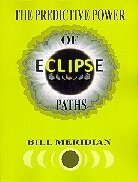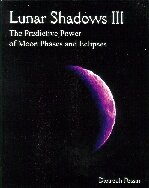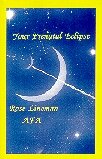
|
The Astrology Center of America, 207 Victory Lane, Bel Air, MD 21014 Tel: 410-638-7761; Toll-free (orders only): 800-475-2272 |
|||||||
|---|---|---|---|---|---|---|---|
| Home | Author Index | Title Index | Subject Index | Vedic Books | Tarot | E-Mail: | |
 |
Astrological Eclipses |
On the evening news, you'll only hear about eclipses when they occur someplace interesting, usually in your own back yard about once every twenty years. In fact, solar and lunar eclipses occur in pairs every six months or so in what we call "Eclipse Seasons". Sometimes you get a bonus: two lunars and a solar, or two solars and a lunar in the space of a single month. Solar eclipses can range in intensity from the moon's just clipping the sun to the dramatic total eclipse. A Lunar eclipse can range from an imperceptible darkening of the lunar disk, to complete disappearance. Unlike solar eclipses, a lunar eclipse is generally visible to half the planet. The importance of eclipses in astrology has long been known, but is still not clearly understood.
 Indicates a book on our Top Ten list. If you would like to find more books like it, click on the star.
Indicates a book on our Top Ten list. If you would like to find more books like it, click on the star.

|
||

|
||

|
||
 |
||
 |
||
 |
||
Special note: Jansky's Interpreting the Eclipses is out of print. The problem that stops reprints is copyright ownership. My previous notes on the subject were mistaken. Copyright on Jansky's books will not expire anytime soon.

207 Victory Lane, Bel Air, MD 21014
Tel: 410-638-7761; Toll-free (orders only): 800-475-2272
| Home | Author Index | Title Index | Subject Index | Vedic Books | Tarot | E-Mail: |
Established 1993, The Astrology Center of America is owned & operated by David Roell.
This entire site (AstroAmerica.com) is copyright 1996, 1997, 1998, 1999, 2000 by William R. Roell.
All rights reserved.